Effect of Carboxyl Group Position on Assembly Behavior and Structure of Hydrocarbon Oil–Carboxylic Acid Compound Collector on Low-Rank Coal Surface: Sum-Frequency Vibration Spectroscopy and Coarse-Grained Molecular Dynamics Simulation Study
Abstract
1. Introduction
2. Results and Discussion
2.1. CGMD Simulation of Assembly Behavior of Carboxylic Acid Compound Collector with Different Carboxylic Group Positions at Low-Rank Coal/Water Interface
2.1.1. Assembly Process Analysis
2.1.2. Analysis of Action Mechanism during Assembly
2.2. Assembly Structure of Carboxylic Acid Compound Collector with Different Carboxylic Group Positions at LRC/Water Interface
2.2.1. SFG Spectral Analysis
2.2.2. Evaluation of Orientation Angle and Conformational Change in Carboxyl Groups at LRC/Water Interface
2.2.3. Evaluation of Orientation Angle and Conformational Change in Methyl Groups at LRC/Water Interface
2.2.4. AFM Adsorption Morphology Characterization
2.3. Flotation Results
3. Materials and Experimental Methods
3.1. Materials
3.2. Coarse-Grained Molecular Dynamics Simulation
3.2.1. Models
3.2.2. Computational Method
3.3. Sum Frequency Generation Spectrometer
3.3.1. SFG Experiments
3.3.2. Calculation of Methyl Orientation Angle of the Interfacial Molecule
3.4. AFM Measurements
3.5. Flotation Experiments
4. Conclusions
Supplementary Materials
Author Contributions
Funding
Data Availability Statement
Acknowledgments
Conflicts of Interest
References
- Klein, D.R. Organic Chemistry, 4th ed.; International Adaptation; Wiley: Hoboken, NJ, USA, 2022. [Google Scholar] [CrossRef]
- Cao, Q.; Cheng, J.; Wen, S.; Li, C.; Bai, S.; Liu, D. A mixed collector system for phosphate flotation. Miner. Eng. 2015, 78, 114–121. [Google Scholar] [CrossRef]
- Quast, K. Flotation of hematite using 18-carbon fatty acids. Miner. Eng. 2021, 160, 106647. [Google Scholar] [CrossRef]
- Tian, Q.; Zhang, Y.; Li, G.; Wang, Y. Application of Carboxylic Acid in Low-Rank Coal Flotation. Int. J. Coal Prep. Util. 2017, 39, 44–53. [Google Scholar] [CrossRef]
- Liu, Z.; Ren, H.; Yang, Z.; Liao, Y.; Cao, Y. Effect of mixed collector addition sequence on the adsorption behavior of low-rank coal surface: Experimental and molecular dynamics simulation study. Powder Technol. 2022, 397, 117119. [Google Scholar] [CrossRef]
- Liu, Z.; Ren, H.; Yang, Z.; Liao, Y.; Wang, Y. Effect of mixing ratio on the adsorption behavior of low-rank coal surface using mixed collectors: Experimental and molecular dynamics simulation study. Int. J. Coal Prep. Util. 2022, 42, 2788–2803. [Google Scholar] [CrossRef]
- Becraft, K.A.; Richmond, G.L. Surfactant adsorption at the salt/water interface: Comparing the conformation and interfacial water structure for selected surfactants. J. Phys. Chem. B 2005, 109, 5108–5117. [Google Scholar] [CrossRef]
- Sun, W.; Wang, J.; Han, H.; Wang, L.; Liu, R.; Sun, W. Advances in flotation reagent interfacial assembly technology. Zhongguo Kuangye Daxue Xuebao/J. China Univ. Min. Technol. 2022, 51, 544–553. [Google Scholar] [CrossRef]
- Liu, G.; Xiao, J.; Liu, J.; Qu, X.; Liu, Q.; Zeng, H.; Yang, X.; Xie, L.; Zhong, H.; Liu, Q.; et al. In situ probing the self-assembly of 3-hexyl-4-amino-1,2,4-triazole-5-thione on chalcopyrite surfaces. Colloids Surfaces A Physicochem. Eng. Asp. 2016, 511, 285–293. [Google Scholar] [CrossRef]
- Han, H.; Hu, Y.; Sun, W.; Li, X.; Chen, K.; Zhu, Y.; Nguyen, A.V.; Tian, M.; Wang, L.; Yue, T.; et al. Novel catalysis mechanisms of benzohydroxamic acid adsorption by lead ions and changes in the surface of scheelite particles. Miner. Eng. 2018, 119, 11–22. [Google Scholar] [CrossRef]
- Han, H.-S.; Liu, W.-L.; Hu, Y.-H.; Sun, W.; Li, X.-D. A novel flotation scheme: Selective flotation of tungsten minerals from calcium minerals using Pb–BHA complexes in Shizhuyuan. Rare Met. 2017, 36, 533–540. [Google Scholar] [CrossRef]
- Cui, W.; Zhang, J.; Chen, J. Surface proximity effect of galena and its influence on synergistic adsorption behavior. Appl. Surf. Sci. 2021, 567, 150847. [Google Scholar] [CrossRef]
- Weiyong, C.; Jianhua, C.; Yuqiong, L.; Ye, C.; Cuihua, Z. Interactions of xanthate molecule with different mineral surfaces: A comparative study of Fe, Pb and Zn sulfide and oxide minerals with coordination chemistry. Miner. Eng. 2020, 159, 106565. [Google Scholar] [CrossRef]
- Kadagala, M.R.; Nikkam, S.; Tripathy, S.K. A review on flotation of coal using mixed reagent systems. Miner. Eng. 2021, 173, 107217. [Google Scholar] [CrossRef]
- Xia, W.; Yang, J.; Liang, C. A short review of improvement in flotation of low rank/oxidized coals by pretreatments. Powder Technol. 2013, 237, 1–8. [Google Scholar] [CrossRef]
- Rai, B. Pradip Modeling self-assembly of surfactants at interfaces. Curr. Opin. Chem. Eng. 2017, 15, 84–94. [Google Scholar] [CrossRef]
- Chang, C.-Y.; Ju, S.-P.; Wang, L.-F.; Chen, C.-C.; Chuang, Y.-C.; Wu, H.-L.; Chen, H.-T. Investigation of the self-assembly of CS and PCL copolymers with different molecular weights in water solution by coarse-grained molecular dynamics simulation. J. Mol. Model. 2017, 23, 151. [Google Scholar] [CrossRef] [PubMed]
- Wang, H.; Zhang, H.; Liu, C.; Yuan, S. Coarse-grained molecular dynamics simulation of self-assembly of polyacrylamide and sodium dodecylsulfate in aqueous solution. J. Colloid Interface Sci. 2012, 386, 205–211. [Google Scholar] [CrossRef]
- Liu, Z.; Liao, Y.; Xu, M.; Wu, H.; Rudolph, M.; Wang, Y. Coarse-Grain molecular model development and dynamics simulations study of dodecane droplet spreading at the coal-water interface. Miner. Eng. 2021, 171, 107121. [Google Scholar] [CrossRef]
- Weeraman, C.; Yatawara, A.K.; Bordenyuk, A.N.; Benderskii, A.V. Effect of Nanoscale Geometry on Molecular Conformation: Vibrational Sum-Frequency Generation of Alkanethiols on Gold Nanoparticles. J. Am. Chem. Soc. 2006, 128, 14244–14245. [Google Scholar] [CrossRef]
- Wang, X.; Liu, J.; Du, H.; Miller, J.D. States of adsorbed dodecyl amine and water at a silica surface as revealed by vibrational spectroscopy. Langmuir 2010, 26, 3407–3414. [Google Scholar] [CrossRef]
- Warr, G.G. Surfactant adsorbed layer structure at solid/solution interfaces: Impact and implications of AFM imaging studies. Curr. Opin. Colloid Interface Sci. 2000, 5, 88–94. [Google Scholar] [CrossRef]
- Piskorz, T.K.; Gobbo, C.; Marrink, S.J.; De Feyter, S.; de Vries, A.H.; van Esch, J.H. Nucleation Mechanisms of Self-Assembled Physisorbed Monolayers on Graphite. J. Phys. Chem. C 2019, 123, 17510–17520. [Google Scholar] [CrossRef]
- Iimori, T.; Iwahashi, T.; Ishii, H.; Seki, K.; Ouchi, Y.; Ozawa, R.; Hamaguchi, H.-O.; Kim, D. Orientational ordering of alkyl chain at the air/liquid interface of ionic liquids studied by sum frequency vibrational spectroscopy. Chem. Phys. Lett. 2004, 389, 321–326. [Google Scholar] [CrossRef]
- Liu, Z.; Dong, X.; Liao, Y.; Fan, Y.; Cao, Y. New insights into the adsorption and assembly of mixed collectors with different carbon chain lengths on the low-rank coal flotation by sum-frequency vibration spectroscopy and molecular dynamics simulation. Powder Technol. 2024, 434, 119294. [Google Scholar] [CrossRef]
- Lu, R.; Gan, W.; Wu, B.-H.; Zhang, Z.; Guo, Y.; Wang, H.-F. C−H Stretching vibrations of methyl, methylene and methine groups at the vapor/Alcohol (n = 1−8) Interfaces. J. Phys. Chem. B 2005, 109, 14118–14129. [Google Scholar] [CrossRef]
- Deng, G. Investigation of Molecular Orientation and Structure at Air/Aqueous Solution Interfaces of Electrolytes and Dye Molecules Using Sum Frequency Generation Spectroscopy. Ph.D. Thesis, University of Science and Technology of China, Hefei, China, 2013. [Google Scholar] [CrossRef]
- Gobbo, C.; Beurroies, I.; de Ridder, D.; Eelkema, R.; Marrink, S.J.; De Feyter, S.; van Esch, J.H.; de Vries, A.H. Martini model for physisorption of organic molecules on graphite. J. Phys. Chem. C 2013, 117, 15623–15631. [Google Scholar] [CrossRef]
- Wu, D.; Yang, X. Coarse-Grained molecular simulation of self-assembly for nonionic surfactants on graphene nanostructures. J. Phys. Chem. B 2012, 116, 12048–12056. [Google Scholar] [CrossRef]
- Williams, C.D.; Lísal, M. Coarse grained models of graphene and graphene oxide for use in aqueous solution. 2D Mater. 2020, 7, 25025. [Google Scholar] [CrossRef]
- Marrink, S.J.; de Vries, A.H.; Mark, A.E. Coarse grained model for semiquantitative lipid simulations. J. Phys. Chem. B 2004, 108, 750–760. [Google Scholar] [CrossRef]
- Marrink, S.J.; Risselada, H.J.; Yefimov, S.; Tieleman, D.P.; de Vries, A.H. The MARTINI force field: Coarse grained model for biomolecular simulations. J. Phys. Chem. B 2007, 111, 7812–7824. [Google Scholar] [CrossRef]
- Yu, C.-C.; Seki, T.; Chiang, K.-Y.; Tang, F.; Sun, S.; Bonn, M.; Nagata, Y. Polarization-Dependent Heterodyne-Detected Sum-Frequency Generation Spectroscopy as a Tool to Explore Surface Molecular Orientation and Ångström-Scale Depth Profiling. J. Phys. Chem. B 2022, 126, 6113–6124. [Google Scholar] [CrossRef] [PubMed]
- Kataoka, S.; Cremer, P.S. Probing molecular structure at interfaces for comparison with bulk solution behavior: Water/2-propanol mixtures monitored by vibrational sum frequency spectroscopy. J. Am. Chem. Soc. 2006, 128, 5516–5522. [Google Scholar] [CrossRef] [PubMed]
- Liljeblad, J.F.D.; Tyrode, E. Vibrational sum frequency spectroscopy studies at solid/liquid interfaces: Influence of the experimental geometry in the spectral shape and enhancement. J. Phys. Chem. C 2012, 116, 22893–22903. [Google Scholar] [CrossRef]
- Wang, H.F.; Gan, W.; Lu, R.; Rao, Y.; Wu, B.H. Quantitative spectral and orientational analysis in surface sum frequency generation vibrational spectroscopy (SFG-VS). Int. Rev. Phys. Chem. 2005, 24, 191–256. [Google Scholar] [CrossRef]
- Wang, F.; Huang, Z.; Cui, Z.-F.; Wang, H.-F. Absolute orientation of molecules with competing hydrophilic head groups at the air/water interface probed with sum frequency generation vibrational Spectroscopy. Chin. J. Chem. Phys. 2009, 22, 197–203. [Google Scholar] [CrossRef]
- Huo, F.; Ding, J.; Tong, J.; He, H. Ionic liquid-air interface probed by sum frequency generation spectroscopy and molecular dynamics simulation: Influence of alkyl chain length and anion volume. Mol. Simul. 2022, 48, 844–854. [Google Scholar] [CrossRef]
- Hirose, C.; Akamatsu, N.; Domen, K. Formulas for the analysis of surface sum-frequency generation spectrum by CH stretching modes of methyl and methylene groups. J. Chem. Phys. 1992, 96, 997–1004. [Google Scholar] [CrossRef]
- Ferrari, M.; Ravera, F.; Viviani, M.; Liggieri, L. Characterization of surfactant aggregates at solid–liquid surfaces by atomic force microscopy. Colloids Surfaces A: Physicochem. Eng. Asp. 2004, 249, 63–67. [Google Scholar] [CrossRef]
- Paiva, P.; Monte, M.; Simão, R.; Gaspar, J. In situ AFM study of potassium oleate adsorption and calcium precipitate formation on an apatite surface. Miner. Eng. 2011, 24, 387–395. [Google Scholar] [CrossRef]
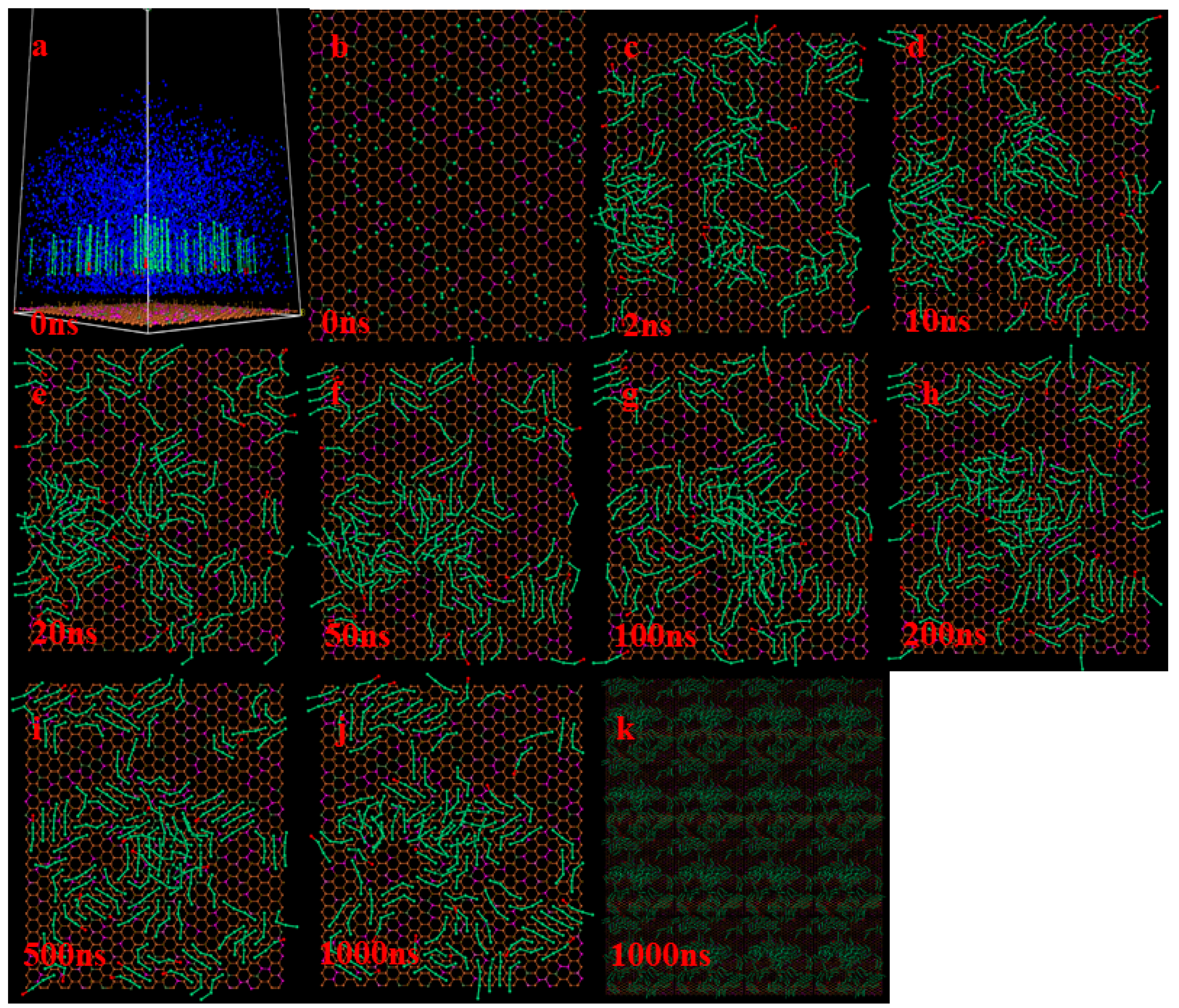

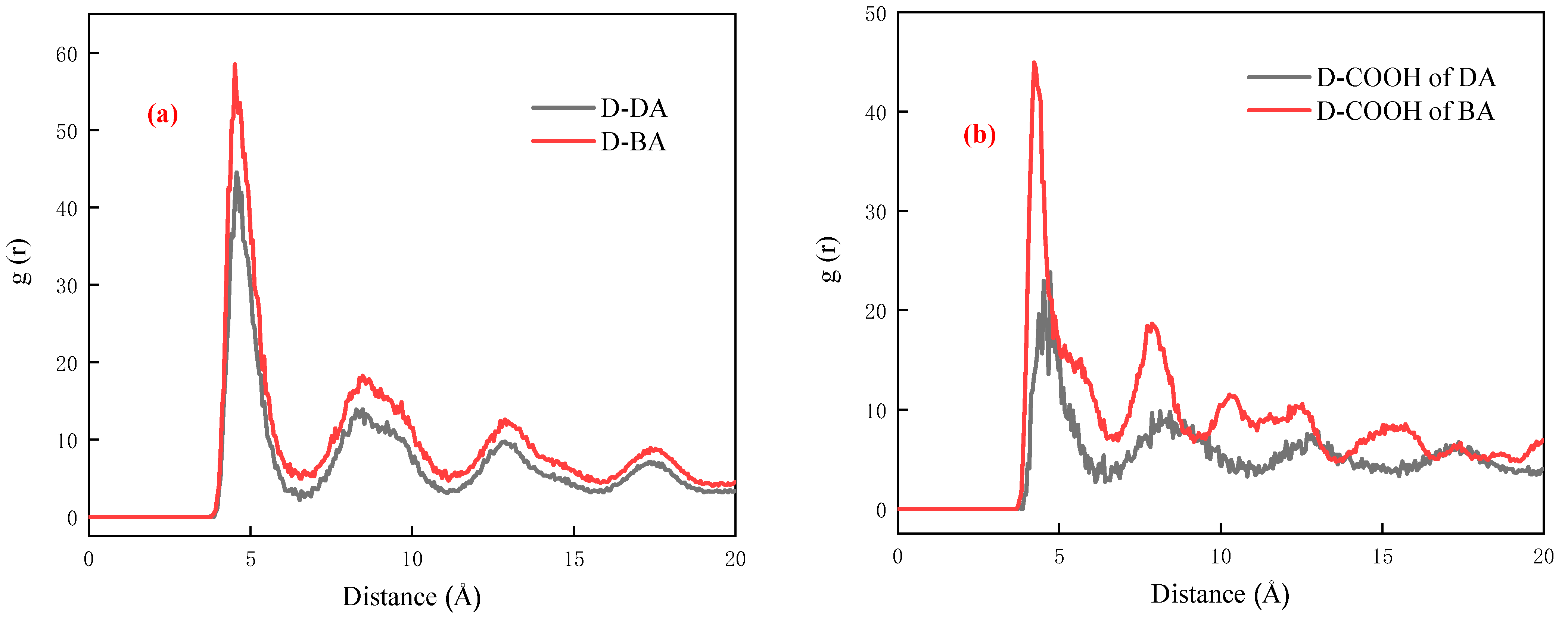
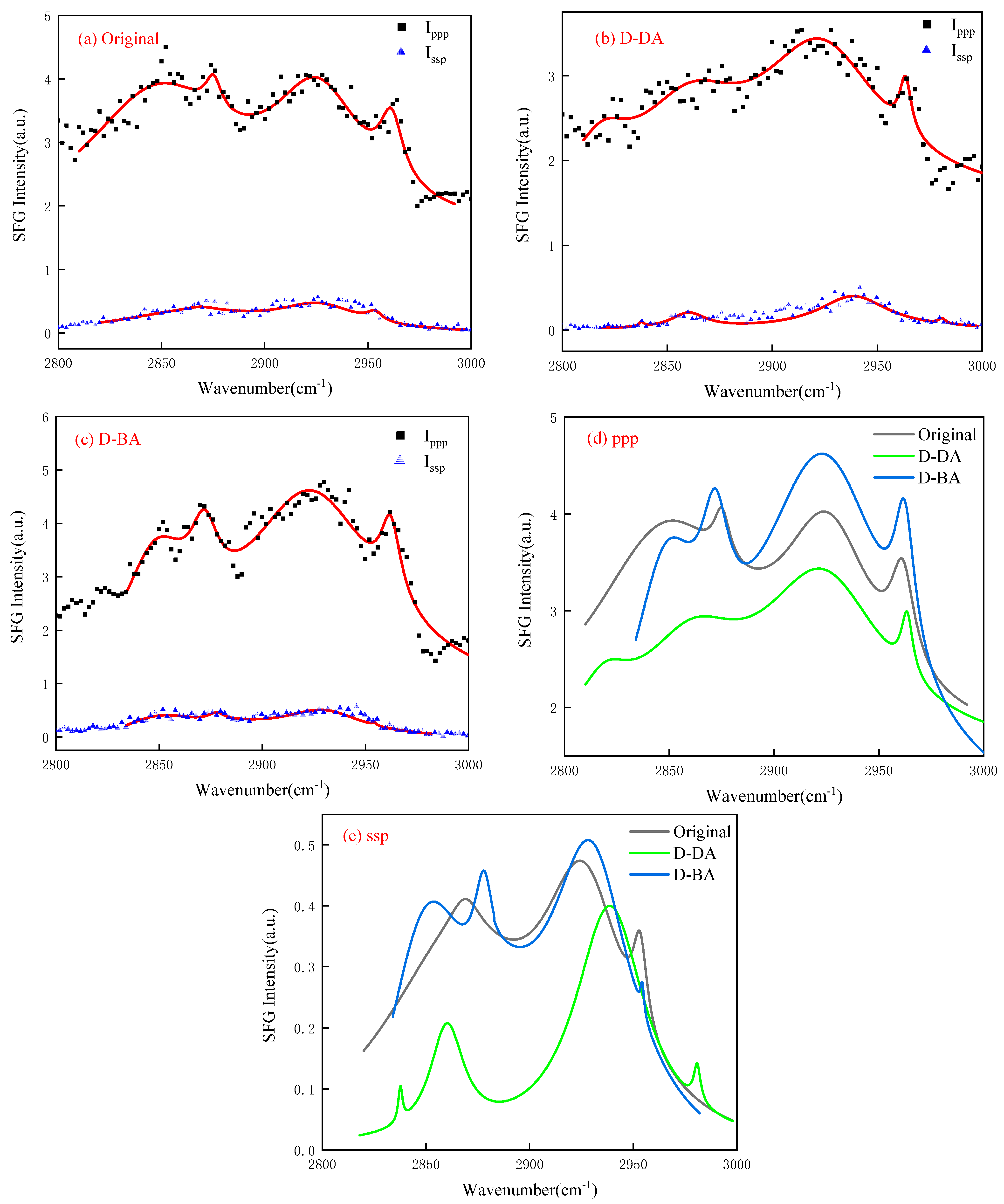
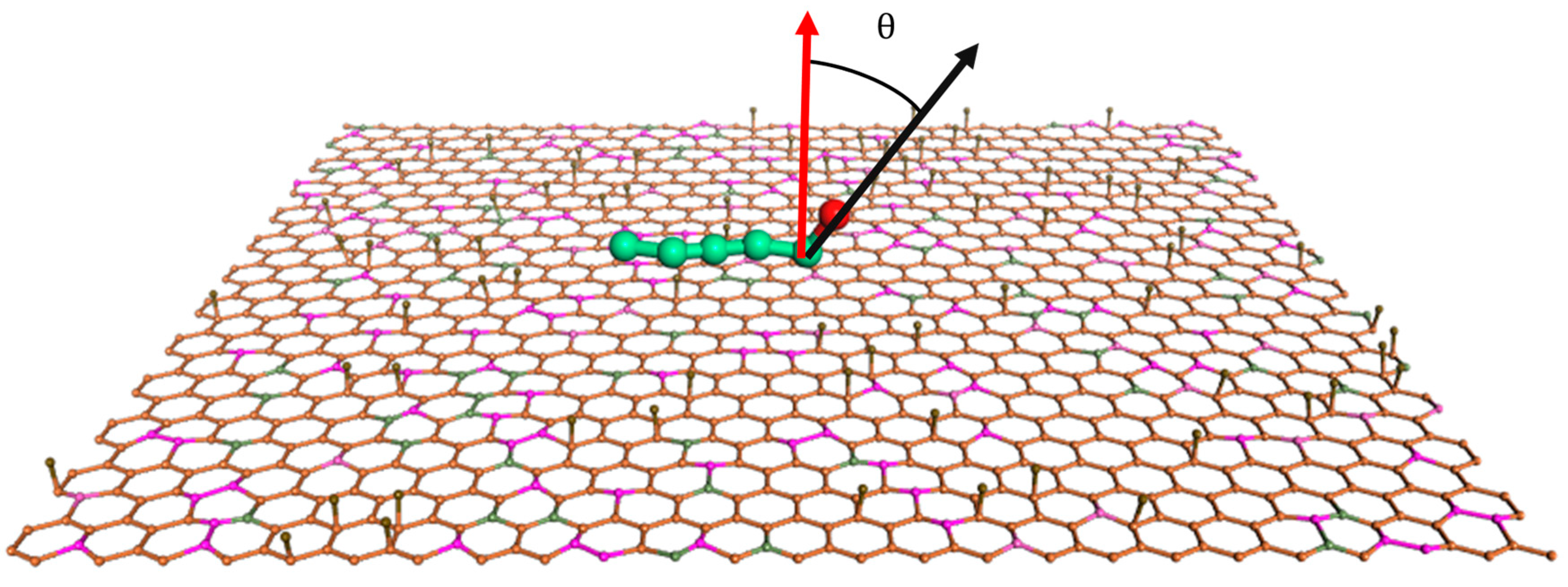

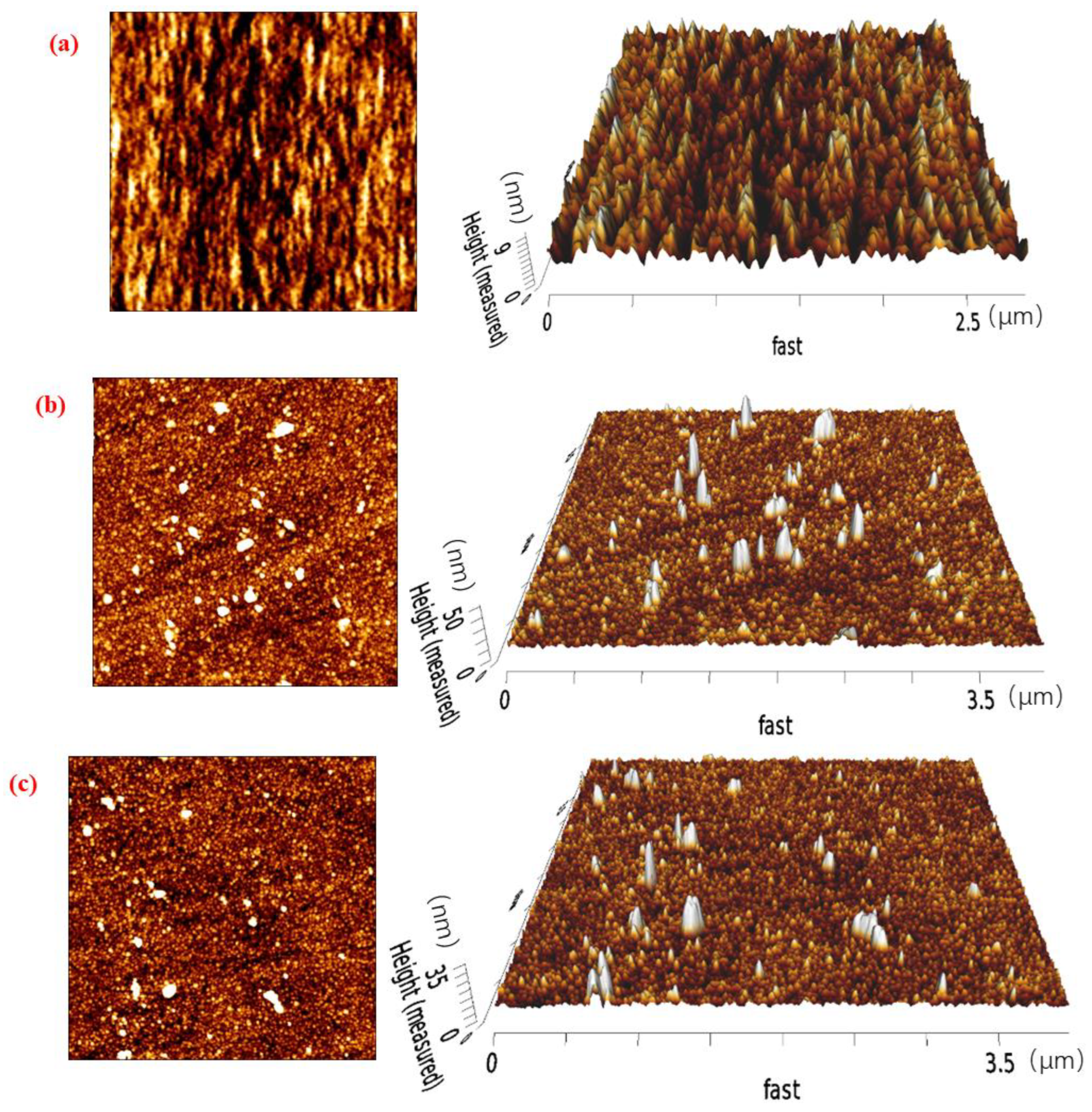


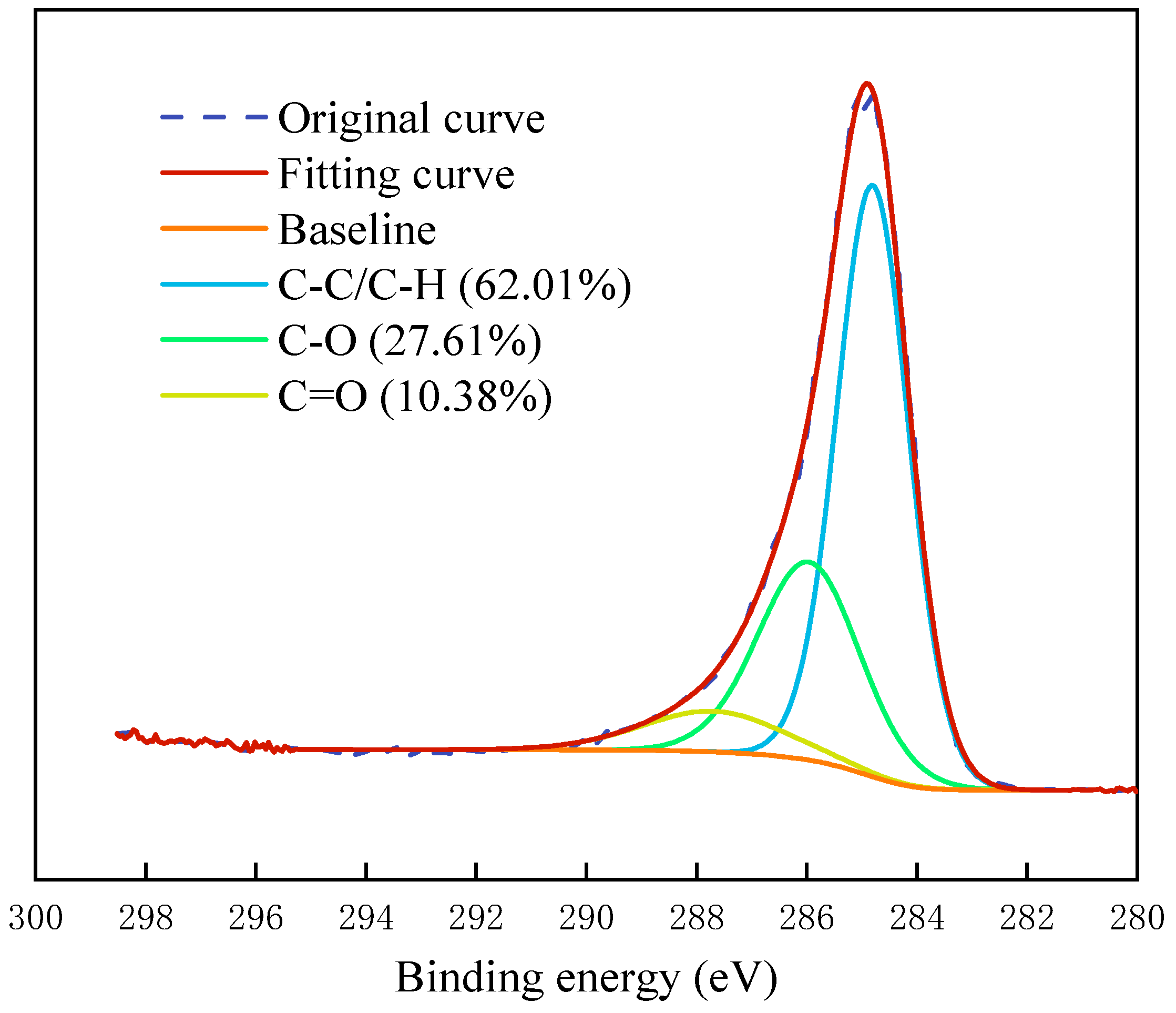

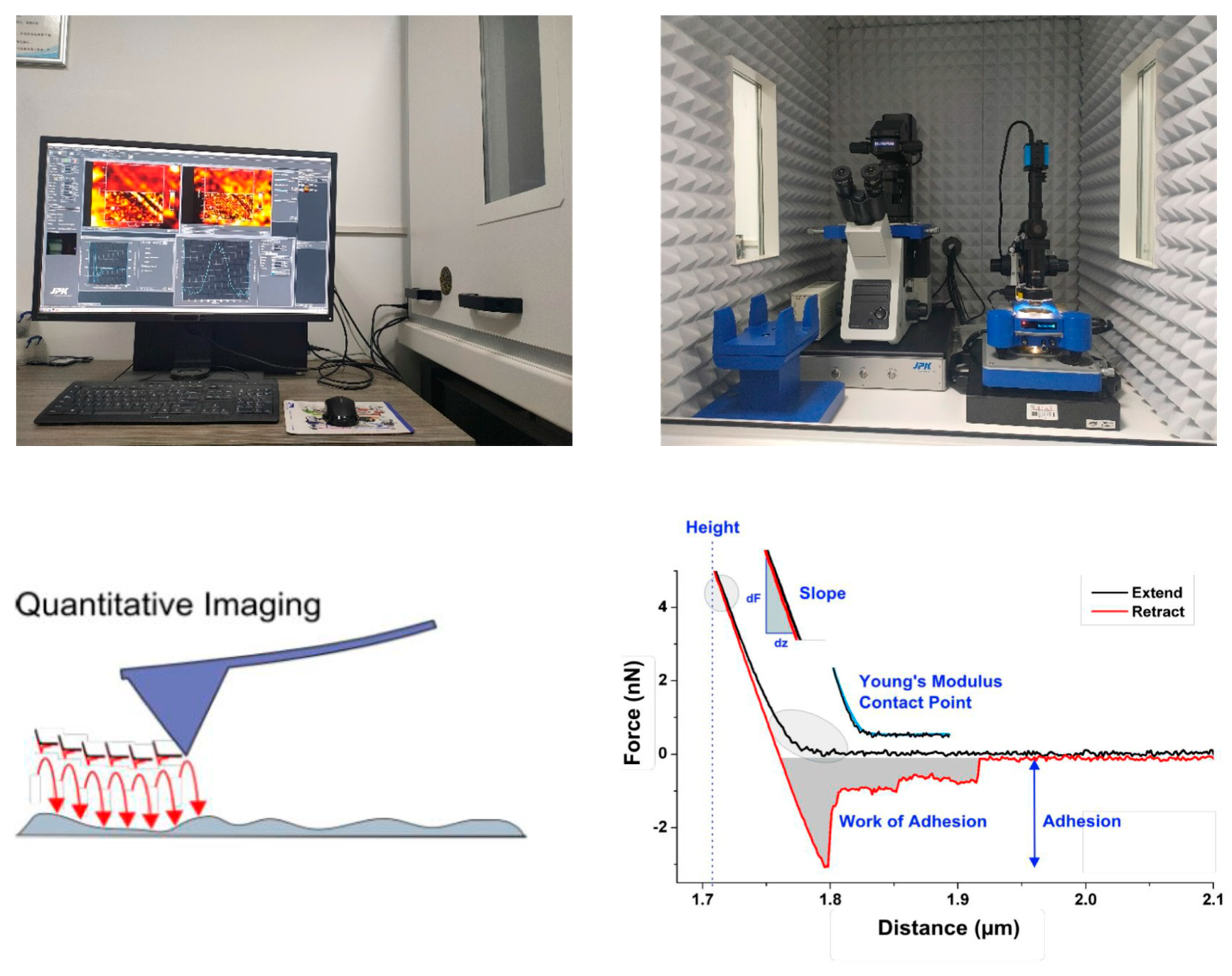
| Wavenumber | ppp Polarization State (cm−1) | ssp Polarization State (cm−1) | ||||||
|---|---|---|---|---|---|---|---|---|
| Samples | CH3, ss | CH3, as | CH2, ss | CH2, as | CH3, ss | CH3, as | CH2, ss | CH2, as |
| Original | 2875 | 2961 | 2852 | 2924 | 2869 | 2955 | - | 2924 |
| D-DA | 2867 | 2963 | 2829 | 2924 | 2860 | 2981 | 2840 | 2939 |
| D-BA | 2872 | 2962 | 2852 | 2923 | 2878 | 2954 | 2854 | 2930 |
Disclaimer/Publisher’s Note: The statements, opinions and data contained in all publications are solely those of the individual author(s) and contributor(s) and not of MDPI and/or the editor(s). MDPI and/or the editor(s) disclaim responsibility for any injury to people or property resulting from any ideas, methods, instructions or products referred to in the content. |
© 2024 by the authors. Licensee MDPI, Basel, Switzerland. This article is an open access article distributed under the terms and conditions of the Creative Commons Attribution (CC BY) license (https://creativecommons.org/licenses/by/4.0/).
Share and Cite
Liu, Z.; Dong, X.; Liao, Y.; Fan, Y.; Cao, Y. Effect of Carboxyl Group Position on Assembly Behavior and Structure of Hydrocarbon Oil–Carboxylic Acid Compound Collector on Low-Rank Coal Surface: Sum-Frequency Vibration Spectroscopy and Coarse-Grained Molecular Dynamics Simulation Study. Molecules 2024, 29, 1034. https://doi.org/10.3390/molecules29051034
Liu Z, Dong X, Liao Y, Fan Y, Cao Y. Effect of Carboxyl Group Position on Assembly Behavior and Structure of Hydrocarbon Oil–Carboxylic Acid Compound Collector on Low-Rank Coal Surface: Sum-Frequency Vibration Spectroscopy and Coarse-Grained Molecular Dynamics Simulation Study. Molecules. 2024; 29(5):1034. https://doi.org/10.3390/molecules29051034
Chicago/Turabian StyleLiu, Zechen, Xianshu Dong, Yinfei Liao, Yuping Fan, and Yijun Cao. 2024. "Effect of Carboxyl Group Position on Assembly Behavior and Structure of Hydrocarbon Oil–Carboxylic Acid Compound Collector on Low-Rank Coal Surface: Sum-Frequency Vibration Spectroscopy and Coarse-Grained Molecular Dynamics Simulation Study" Molecules 29, no. 5: 1034. https://doi.org/10.3390/molecules29051034
APA StyleLiu, Z., Dong, X., Liao, Y., Fan, Y., & Cao, Y. (2024). Effect of Carboxyl Group Position on Assembly Behavior and Structure of Hydrocarbon Oil–Carboxylic Acid Compound Collector on Low-Rank Coal Surface: Sum-Frequency Vibration Spectroscopy and Coarse-Grained Molecular Dynamics Simulation Study. Molecules, 29(5), 1034. https://doi.org/10.3390/molecules29051034









